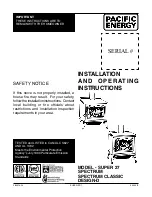
8.3 Inlet pressure check.
The appliance is pre-set to give the correct
heat input at the inlet pressure shown in
section 2 of this manual. No adjustment is
necessary.
1.
Ensure that the stove is turned OFF before
removing the presure test point sealing
screw. Check the inlet pressure by fitting a
pressure gauge at the test point. The test
point is on the inlet ‘T’ connector (See figure
12). Check the pressure with the appliance
alight and set at maximum output.
2.
After checking, turn off the appliance. Remove the pressure gauge and replace the
test point sealing screw.
3.
Test around the sealing screw for gas soundness with a suitable leak detection
fluid.
9. SPILLAGE AND FLAME SUPERVISION CHECKS
9.1 Check for spillage.
1.
Close all doors and windows in the room containing the appliance.
2.
Light the appliance and turn the control knob to the ‘HIGH’ position.
3.
Leave the appliance on for five minutes.
4.
A smoke match should be placed close to base of the diverter box. The installation
is satisfactory if the smoke is drawn into the appliance/ flue way. Do not use a lighted
match or a naked flame.
If the smoke is not drawn into the appliance leave the appliance alight at the
maximum setting for a further
ten minutes
and then repeat the test. If the smoke is
still not drawn into the appliance then
disconnect the appliance and seek expert
advice.
5.
If the above test is satisfactory open all internal connecting doors, hatches, etc. in
the room. Keep all doors and windows that open to the outside of the building closed.
Recheck for spillage as above. If an extractor fan is installed in the same room as the
appliance or a connecting room, check that spillage does not occur with the fan
operating and all doors and other openings between the fan and the appliance open.
If the smoke is drawn into the appliance, continue with the installation. If the test is
not satisfactory
disconnect the appliance and advise the customer of the cause
of failure.
Page 18
©
GDC Group Ltd. 2015
OWNER GUIDE
Figure 12.
















































